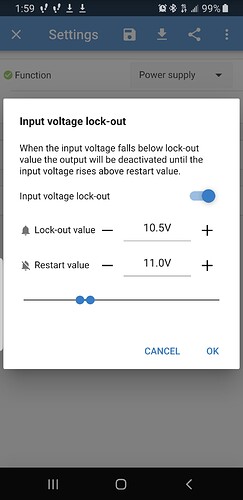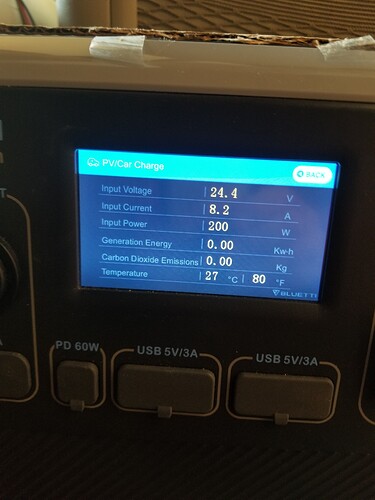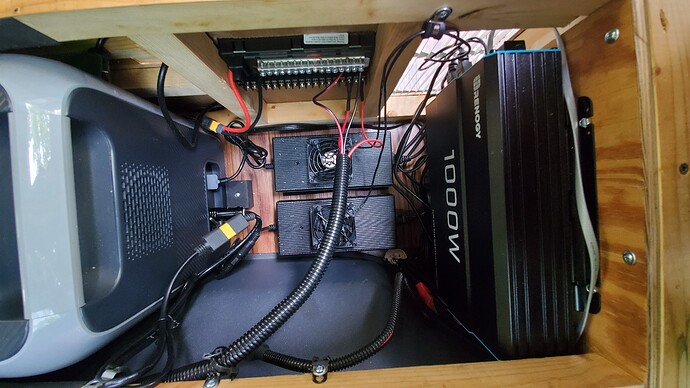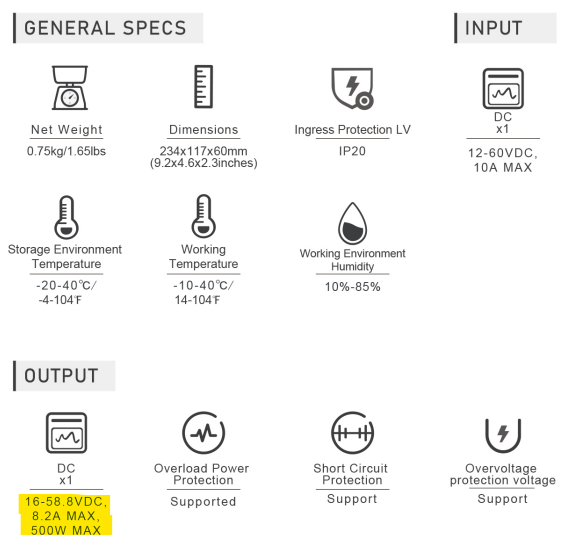I feel the exact same way. This is not a 40 volt unit, it is 40 amps. You keep confusing volts with amps. You must have 35 volts or more to fast charge and the Renogy unit pictured does not provide that. If you are going to power a Cpap machine all night, I would suggest using a Bluetti EB70 and car charge it while driving. The AC200 consumes a larger amount of power just being turned on due to its size and will have consumed more power overnight than the EB70 would.
Scott, I reset the Victron charger to its factory specs
and double checked as per your suggestion if the Bluetti was in car charge mode and not PV. The Victron now appears to be putting out 200 watts to the Bluetti.
I’m OK with that. Thanks again! Tom
Good to hear. 200 watts is a good charge rate and won’t over stress your alternator
You could prob raise the output voltage of the victron to 25.5 or 26 and get a few more watts of charging power
Thank you for your recommendations! Tom
Check out this link for discussion of high wattage vehicle charging from a couple of users. That will give you around 575 watts of charging power while driving
I went a different route. I have a 1000 watt inverter hooked to my vans battery. 150amp alternator in my van btw. I have two 400 watt chargers plugged into my inverter and can charge my bluetti up in under 2.5 hours while driving. However I am usually only running one charger at a time and only use the 2nd one in an emergency. I also have two USB computer fans plugged into the inverter which cool the charging bricks.
I’ve found that I’ll flip my 70amp breaker if I run the AC and both charging bricks. Thinking about upgrading my alternator.
Bluetti now makes a 500watt charger which I’d like to replace one of my 400 watt chargers with.
I would have went DC to DC charging but the seller helping me with the build didn’t recommend it and it wasn’t a thought till after. I’m still considering switching out the AC inverter to DC to DC because I’m sure there some wasted power. 800 watts to 700 watts isn’t much of a difference if you’re making long drives anyways. The real test would be getting two of the 500watt charging bricks and pumping 1000watts in while driving but I don’t think I have the proper wire guage for all of that power and would definitely need to upgrade my alternator.
Looks like a nice clean install. Well thought out and executed. The heaviest ga. wire would be the run from your AC inverter to the battery and you can’t go too heavy ga. if you are running over 1,000 watts. With your AC inverter you also have back up redundancy with the ability to use the Renogy for any number of things in addition to charging.
What is your experience running the two fans on the charging bricks? Temps much lower?
Thank you!
I have 4awg running about 15 feet to the vans battery. 30 feet total. I’ve received conflicting information about if it’s sufficient to pump 800watts through (or what ever wattage two power bricks consume) I have tested it from 50% and it charges to 100% in just over an hour. I get enough solar that I haven’t had it go below 50% when I’m camping.
As far as temp I need a thermal temp reader to get you that answer. One video I watched said their power brick got up to 140°F. I’ve noticed that they aren’t as hot to the touch as before I put the fans on but that’s anecdotal until I actually get a temp reading.
And I agree about the redundancy, if I ever take the AC200p to power the house I still have an inverter to power stuff in the van.
If you were to up the capacity of the inverter, I would go with larger cable. 15’ is quite a length when you are pushing that many amps.
Would this option practical to charge via the AC input port with the new D050S DC CHARGING ENHANCER? I would ideally like to have solar via the aviation port and then vehicle charging as backup whenever the vehicle is running without having to unplug/replug cables in. I didn’t think much of charging with the AC port (besides for AC charging of course) but when the D050S was announced it got me thinking.
One option could but just to used the voltage converter like you have mentioned above to the D050S then to the AC port. But looking at the D050S manual online it states the output is 16-58.8V, 8.2A max (screenshot below). Does this mean the AC port can take current straight out of the voltage converter around 48V and under 8.2A? That would eliminate the need for the D050S all together if you could limit the current to under 8.2A.
Just trying to get the most efficient and cost effective way to both solar and vehicle charge. If none of that makes sense, please let me know.
The voltage has to be very close to 58.5. The 8.2 amps x the input voltage is the approx wattage input to the AC200
Hi, really cool ideas!!! I tried your inverter solution and the charger shuts down (apparently it’s a voltage drop)…
Alternator 180amp
Invertor 1000w continious/2000w surge
Distance from battery to inverter 1m 16mm2 cable
I cannot. understand where the problem comes from… any ideas?
This afternoon i will check if the inverter input and outputs are steady.
I am assuming you are trying to charge an AC200 series with the included AC charging brick powered by a DC to AC inverter in your vehicle.
I would first check the input voltage to the inverter under the load to insure that you have at least 12 volts with the load. Second check the output voltage of the inverter under load and make sure it matches up with the input specs of the charging brick of the AC200
If you are saying you cable form the battery to the inverter is 1 meter and the cables are 16mm in thickness, that should be way more then sufficient to carry the needed amps from battery to converter. The AC power brick is going to pull around 500 watts of AC load so a 1,000 watt inverter should be sufficient. Not sure what you mean by charger shutting down. I would also try the inverter on another load of around 500 watts and also 1,000 watts just to test the inverter / installation.
Drive for about 15 miles and then try to start it up. Low voltage alarm came on my inverter the first time i tried to boot it up because the cars battery voltage was low
It sounds like the size of your wire feeding your inverter may be too small as well.
Now thinking about this again…
With these dc-dc converters, is there an easy way to prevent it draining the battery when the engine is not working.
I was thinking of adding it under the hood of my van, but can’t see an easy way to prevent it draining the battery. Is there something you can fit so it recognizes the higher voltage from the alternator when the engine is running and turn on?
You can add a relay switch to turn it on and off or you could wire the same switch to be triggered to the ignition on switch so it only operates when the key is on
Apologies if this is a stupid question, but trying to get my head around it.
I think I can find a power source that’s only powering when the engine is running. But, I believe it’s a 10a output. So, in theory, I can buy a 12vto24v 10a converter and get 240W charging. or a 12-48V 10a converter and get 480w. Is that correcct?
I’m planning on wiring it into the Bluetti DS050S charger. I just need an XT90 connecter straight into the bluetti from the converter?
You won’t get any more than the 10 amps at 12 volts or about 120 watts. When you double the voltage it take double the amps so you would need over 20 amps for the 24 volt and 40 plus amps for the 48 volts



